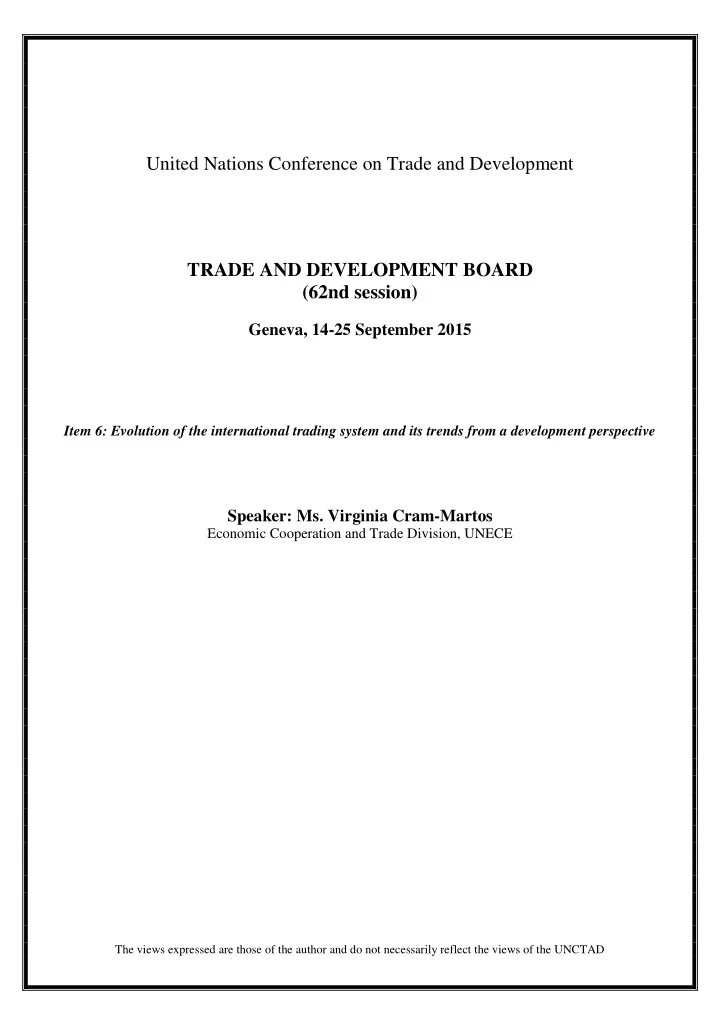

United Nations Conference on Trade and Development TRADE AND DEVELOPMENT BOARD (62nd session) Geneva, 14-25 September 2015 Item 6: Evolution of the international trading system and its trends from a development perspective Speaker: Ms. Virginia Cram-Martos Economic Cooperation and Trade Division, UNECE The views expressed are those of the author and do not necessarily reflect the views of the UNCTAD
TRADE Unlocking the Potential for Sustainable Development Virginia Cram-Martos Director Economic Cooperation and Trade Division 22 September 2015
UNECE’s Trade Interventions and the SDGs Goal 2: End hunger, food Goal 8: Sustainable security, nutrition, Economic Growth sustainable agriculture Goal 9: Resilient infrastructure, Goal 3: Healthy Lives industrialization and innovation Goal 17: Means of Goal 12: Sustainable implementation and consumption and revitalize global production patterns partnership
Increased Trade Transparency and Efficiency One UNECE key contribution to the SDGs Standards Harmonization Simplification
Trade Facilitation and Electronic Business The UN Centre for Trade Facilitation and Electronic Business (UN/CEFACT) has produced more than 480 standards and recommendations for trade facilitation and electronic business Overview of the Buy-Ship-Pay Model
UN Trade Facilitation Implementation Guide A web-based interactive tool in a www.tfig.unece.org wikipedia style available in Arabic, English, French, Russian and Spanish Purpose: Present concepts, standards and recommendations that can help simplify trade throughout the International Supply Chain. Target: Policymakers, technical experts, from governments, businesses and international organizations
Example: Greece UNECE Technical Assistance for Trade Facilitation Implementation • Since 2012, Greece has improved its ranking in the World Bank Doing Business study by 39 positions from position 100 to 61 in 2014. • The competitive position of Greece in the Logistic Performance Index has improved by 25 positions. The concrete results for Customs are overwhelming with an improvement by 52 positions, from 94 to 42 . • The time to export and import has been reduced by 25% and 44% respectively. • The cost to export and import has gone down by approximately 10%.
Example: Export of Cotton Fibres from Tajikistan 3-16 days 16 11 2 day 1 day 1 day 12 3 day 1 day 1 day 9 10 6 7 8 5 2 days 4 1 day 1 day 5 days 2 3 5 1 # process 1 2 3 4 5 6 7 8 9 10 1. Buy: Conclude sales contract 7. Ship: Obtain cetificate of origin 2. Buy: Obtain confirmation receit payment letter from bank 8. Ship: Arrange inspection and fumigation 3. Ship: Obtain quality certificate from ginnery 9. Ship: Obtain confirmation of tax payment 4. Ship: Arrange transport 10. Ship: Arrange customs clearance 5. Ship: Obtain conformity certificate 11. Ship: Delivery of goods 6. Ship: Loading Source: UNECE Study on Regulatory Barriers to Trade in Tajikistan 2014
Agricultural Quality Standards Fresh Fruit and Vegetables More than 100 international Dry and Dried Seed potatoes agricultural Produce quality standards Mea t
Regulatory Cooperation and Standardization Regulatory cooperation More than 15 Risk recommendations Market Management on standardization surveillance in Regulatory and regulatory Frameworks cooperation Education on standards- related issues
Studies on Regulatory and Procedural Barriers to Trade Tajikistan Belarus Kazakhstan 2014 2013 2012
Promoting Innovation and Competitiveness Innovation enables stronger economic growth with less ecological impact => SDG 9 (and others) BUT: innovation needs a nurturing eco-system => policy support for it to emerge
Innovation and Competitiveness Policies Good Practices & Policy Exchanges of Policy Advice & Recommendations Experience Capacity Building
Mega trend 1 – Global connectedness 2.8 Billion Mobile Broadband Subscriptions 150 Billion Worldwide App Downloads 9,300 ExaByte Worldwide Data Creation $17,900 Billion Worldwide eCommerce Transactions Huawei Global Connectivity Index 2015
Mega trend 1 – Global connectedness
Megatrend 2 : Center of economic gravity Merchandise • Over half of merchandise exports from developing economies are sent to other developing economies Exports (2013) • Developing economies’ exports to least -developed Merchandise countries (LDCs) in 2013 grew by 8 per cent, compared with 10 per cent in 2012. Exports to • Developed economies’ exports to LDCs grew by 3 LDCs (2013) per cent following stagnation the previous year Commercial • Since 2000, exports of commercial services from least-developed countries (LDCs) have grown by 14 Services per cent per year on average, a much higher growth (2013) rate than in other economies (9 per cent on average) Source: World Trade Development (2013): https://www.wto.org/english/res_e/statis_e/its2014_e/its14_highlights1_e.pdf
Megatrend 2 : Center of Economic Gravity 1995 World Imports 1990 Low and Middle Income Countries = 20% of GDP 2013 Low and Middle Income Countries = 40% of GDP 2013 World Imports
Mega trend 3: Technological change and its adoption Mobile Phone Subscription (Per 100 habitants) 140.0 120.0 100.0 80.0 60.0 40.0 20.0 - 2005 2006 2007 2008 2009 2010 2011 2012 2013 2014 2015* Per 100 inhabitants Developed Developing World
Mega trend 3: Technological change and its adoption Solar PV generation and projection by region IEA, (2014), Medium-Term Renewable Energy Market Report 2014 , OECD/IEA, Paris
Mega trend 4: Urbanization and Demographic Trends
Mega trend 5: The Impact of Human Activity – Climate Change Of the 15 hottest years since record keeping began 130 years ago 14 occurred between 2000 and 2015
THANK YOU You are invited to contact us at trade@unece.org
Recommend
More recommend